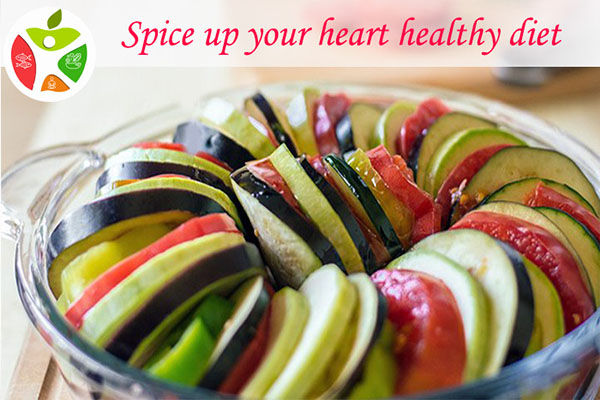Spice up your heart healthy diet
Healthy eating does not mean a tasteless flavorless meal. In a research done on the amount of antioxidants found in commonly consumed foods, it was found that among the 50 top ranking antioxidant rich foods, 13 were spices. The spices mentioned are cloves, oregano, ginger (ground), cinnamon, turmeric powder, curry powder, red pepper, turmeric powder, curry powder, paprika, parsley, black pepper and Yellow mustard. In fact, proper combination of spices (herbs) means that one doesn’t miss the salt when on a low salt diet. (The Dietary Guidelines for Americans 2005)
Researches have shown that various herbs used as spices in food possess hypolipidemic, antiplatelet, antitumor, or immune-stimulating properties that may be useful in helping to reduce the risk of cardiovascular disease and cancer. These have a wide variety of active phytochemicals, including the flavonoids, terpenoids, lignans, sulfides, polyphenols, carotenoids, coumarins, saponins, plant sterols, curcumins, and phthalides, These have extremely valuable disease fighting properties. Ginger alone has some 25 different antioxidants. Garlic, rosemary, cinnamon, coriander, fenugreek, ginger, oregano, mustard and thyme have protective effect against high cholesterol, atherosclerosis and high blood pressure.
Garlic stimulates the synthetic production of nitric oxide which is important for vascular dilation, thereby helping in lowering blood pressure and due to the presence of a compound ajoene, it is helpful in preventing platelet aggregation.
Ginger has been shown to lower dangerously high lipid and cholesterol levels, this is due to fact that it inhibits fat absorption from the intestines.
Oregano, contains caravacrol and rosemarinic acid which inhibit the formation of atheromatus plaques. Oleanolic and ursolic acid, are effective in lowering blood lipid levels and eugenol prevents thrombus formation.
Cloves is loaded with highly effective antioxidants including procyanidin and quercetin that give this spice the distinction of having the highest antioxidant activity of all foods. It also contains eugenol and eugenol acetate which inhibit platelet aggregation and thus protect against heart disease.
Rosemary is rich in carvacrol and rosmarinic acid, which prevent the formation of atheromatous plaques in the arteries. Oleanolic and ursolic acid reduce the risk of atherogenesis by lowering abnormal blood lipid levels, while caffeic acid prevents platelet aggregation.
Capsaicinoid, the class of active ingredients in red peppers that imparts pungency, accelerates energy expenditure and increases lipid oxidation by activating the sympathetic nervous system. Human studies also suggest that consuming capsaicin decreases energy and fat intake and increases satiety.
Turmeric, also a popular spice contained in curry powder, has potential health benefits due to its active polyphenolic component, curcumin. Curcumin gives turmeric its yellow.
Cinnamon is a widely used spice, most notably used in baked foods and warm winter beverages. Researches have suggested that cinnamon may lower blood glucose levels, increase insulin sensitivity, and/or improve lipid profiles.
All this means that sprinkling some spice on to the food not only adds flavor, but also imparts health benefits. The wisdom of many cultures, both ancient and modern, from around the world emphasizes the importance of enjoying good food.
Free Consultation with: Best Nutritionist in Delhi
Good flavorful tasty food goes hand in hand with healthful food.

